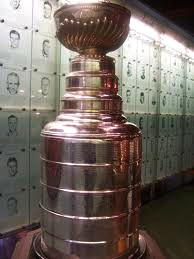The Stanley Cup: Sports Oldest Trophy

- March 29, 2012 New York Post Classroom Extra— Robin Wallace
Professional hockey’s championship playoff tournament is named for sports’ oldest trophy.
Photo: Google Image
WHEN the National Hockey League’s top two teams face off for the league’s championship in a few months, they will be vying for possession of one of the most famous trophies in professional sports. Unlike other professional sports, where a new trophy is made each year for the winning team, there is only one Stanley Cup. It is the oldest trophy in professional sports, passed each year from championship team to championship team, dating back to 1893. The winning team gets to keep the trophy for a year, until it hands it over to the next season’s champions.
The Stanley Cup is, in fact, an enormous bowl that sits on top of a cylindrical collar and base. Inscribed on the chalice are the names of each of the championship teams’ players, coaches and staff, and the year of their championship. The original bowl, which was retired in 1969, was made of silver, but the replacement bowl, as well as the base, is made of silver and nickel alloy. It measures 35-1/4 inches tall and weighs 34-1/2 pounds.
The cup is presented to the captain of the winning team, and each player takes a turn skating around the ice, holding the trophy overhead. It is also a tradition for the winning team to drink champagne out of the cup. The cup then goes on the road with the team, where it appears at games and parades, and is taken home by individual players and coaches. The Stanley Cup has had many legendary adventures while in the hands of its players.
The Stanley Cup is named for Lord Stanley of Preston, who was the governor-general of Canada from 1888 to 1893. Lord Stanley and his family were great hockey fans. Lord Stanley loved the game so much that in 1892 he instructed an aide to purchase a silver punch bowl in England to be a suitable trophy (the base was added later). He named the trophy the Dominion Hockey Challenge Cup, and also established a set of rules for the management of the trophy – among them that the trophy would be passed from team to team each year, and that the winning team would have the right to engrave their name on the trophy. The trophy was first presented in 1893 to the Montreal Amateur Athletic Association (AAA’S) Montreal Hockey Club (MHC).
At the time when the cup was introduced, the championship title was awarded to the team with the best regular season record. When four teams finished the season with tied records in 1894, league organizers negotiated a series of playoff games, which have since evolved into the Stanley Cup finals.
Originally, the cup was intended as a “challenge” cup, meaning it was won when one team challenged another to compete for the best in the league. Sometimes, teams could be called on to defend their title several times during a season. As the organization of hockey evolved, the prestige of winning the Stanley Cup also grew. Eventually, a new trophy was introduced for amateur championships, and the Stanley Cup became the championship trophy for professional hockey.
By 1926, the National Hockey League had for the most part taken over professional hockey, and the Stanley Cup became the prize of the NHL championship, though other leagues could still issue challenges for the cup. In 1947, the NHL reached a formal agreement with the Stanley Cup’s board of trustees granting full control of the cup to the NHL, and allowing the NHL to reject challenges for the cup from other leagues.
First hockey game on TV! Oct. 11, 1952



